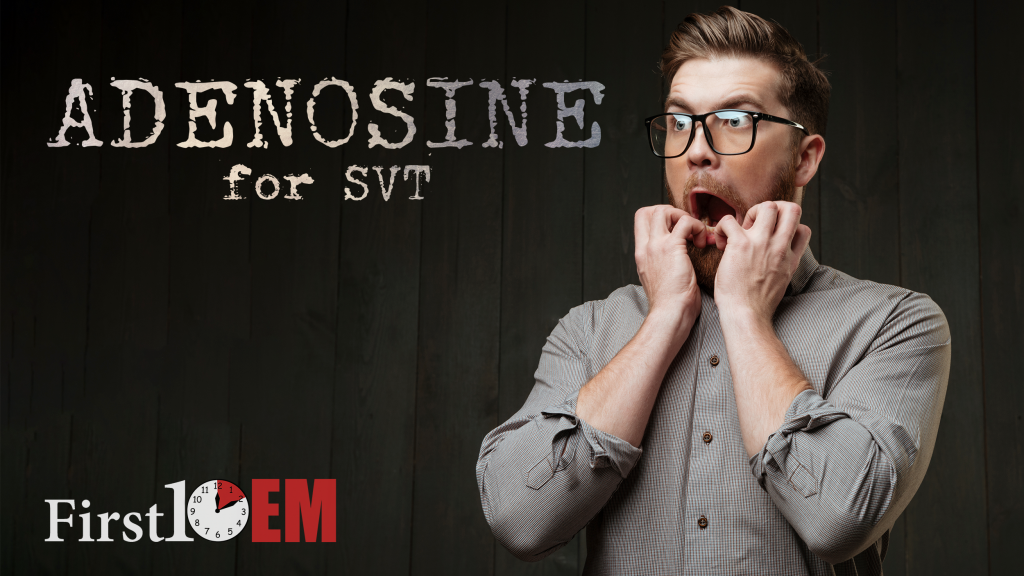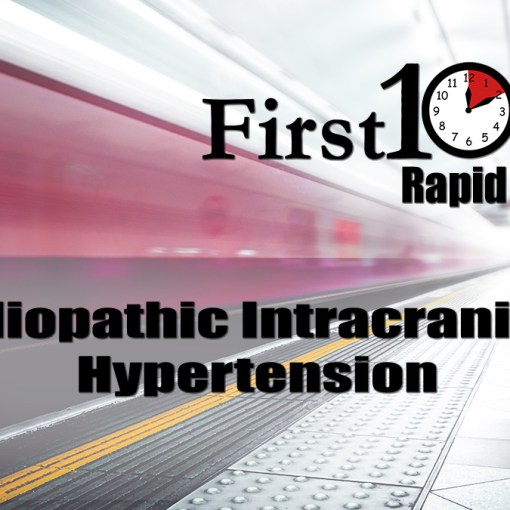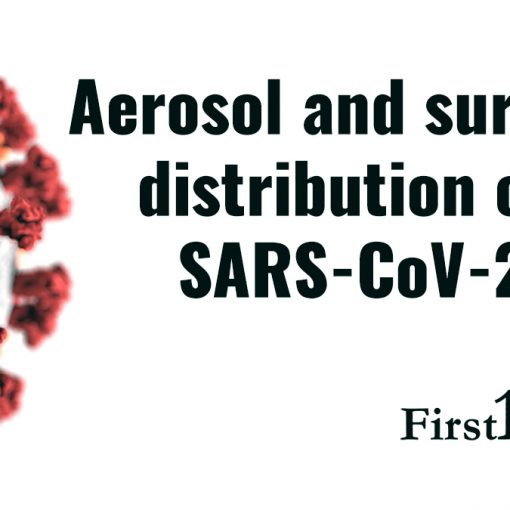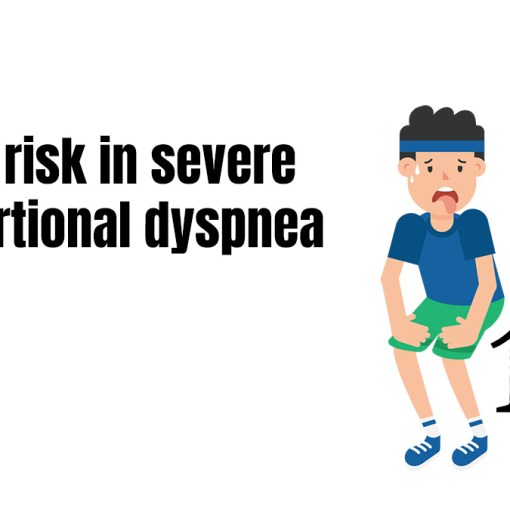Morgenstern, J. Would you choose adenosine?, First10EM, September 5, 2017. Available at:
https://doi.org/10.51684/FIRS.4873
Hi sir. My name is Dr. Morgenstern. That racing feeling in your chest… it’s something we call SVT. That just means that you heart is going too fast. I’m going to get it slowed down for you. All that silly stuff we just did – getting you to blow in a syringe and raising your legs above your head – that sometimes works, but honestly, I have never seen it work myself. It’s time to stop asking you to “bear down” and move on to using medications to slow your heart down. Right now, your blood pressure is fine and you have no other problems, so we have a few options.
Option number one is a medication that works about 90% of the time, but it causes a horrible feeling when it is given. Some people describe it as chest pain. Others say is feels like they are going to die. Most people tell me it is the worst thing they have ever experienced.
Option number two is a medication that works closer to 100% of the time and doesn’t cause any pain at all.
Which would you prefer?
When I consider the possible informed consent or shared decision making conversations around adenosine, I am often surprised it is ever used in the emergency department. Although the vignette is slightly tongue in cheek, the underlying truth is that we frequently give patients a medication that results in significant discomfort when an equally effective medication exists with none of the side effects. If our patients were aware, I think they might revolt.
First, let me start with a little bit of evidence. How does adenosine compare to its primary competitors, the calcium channel blockers?
The Evidence
The first paper I ever encountered on this topic was an RCT by Lim in 2009. In 206 adult patients with SVT, 104 were given adenosine (6mg IV push, followed by 12 mg IV push if not successful), 54 were given diltiazem (2.5 mg/min to a max of 50 mg), and 48 were given verapamil (1 mg/min to a max of 20 mg). The calcium channel blockers were better than adenosine at converting patients back to sinus rhythm (98% vs 86.5%, p=0.002, RR 1.13, 95% CI 1.04-1.23). Blood pressure did drop in the calcium channel group, but the changes (about 10 mmHg systolic) were minor and likely clinically insignificant. By 30 minutes, blood pressure had returned to pretreatment levels. They also do a cost comparison and the adenosine treatment was more expensive.
There is also a Cochrane review on this topic, done in 2006 by Holdgate. They identified 8 RCTs comparing adenosine to calcium channel blockers. Overall, there was no difference in the rate of conversion. There were more adverse events with adenosine (10.8% vs 0.6%, p<0.001, OR 0.15, 95% CI 0.09 to 0.26). (The authors classify these as minor, but minor is not a word I have ever heard from a patient given adenosine). There were no differences in significant adverse events. Although not statistically significant, recurrent SVT occurred more often with adenosine (10% vs 2%, p=0.09).
There was supposed to be an update of the Cochrane review in 2012, but it was withdrawn because of lack of resources to get it done. The search had been completed, and 2 new trials had been found (including Lim), which did not change the overall conclusions of the review. There is a similar meta-analysis by Delaney in 2011 that essentially confirms the results of the Cochrane review.
Bottom line: The studies aren’t huge, but calcium channel blockers seem to be a better choice than adenosine as a first line agent in the management of SVT.
An important caveat: this evidence does not apply to sick patients. Patients were excluded from these studies if they had altered mental status, respiratory distress, or hypotension. Calcium channel blockers are not the ideal first line agent for patients in cardiogenic shock.
What is the best management option for a sick patient with SVT? Prompt electrical cardioversion is the best answer. A trial of adenosine might be reasonable if it will be quicker to administer than electricity, but if the patient is sick they need joules.
Of course, there is also an important role for clinical judgement when managing a patient with SVT. I am not calling for an outright ban on adenosine. There are clearly patients in whom the risk of hypotension outweighs the problem of momentary pain and suffering. We occasionally have to perform painful procedures on patients who are not fully sedated or adequately analgesed. That is emergency medicine, but we should not discount that suffering.
A couple practical points
- Hypotension seems to be more common with verapamil than with diltiazem (although I have not seen a head to head comparison). I tend to stick with diltiazem.
- Go low and go slow. Although the diltiazem dose used in the Lim study was 2.5 mg/min to a maximum of 50 mg, 75% of patients had converted by 18mg. I tend to give 15 mg of diltiazem over 10 minutes. It almost always works, but when it doesn’t I just repeat the dose.
- Always be prepared. Although SVT patients almost never crash, you should always be prepared to cardiovert any emergency department patient with an arrhythmia. At the doses I use, calcium channel blocker induced hypotension is almost never a problem. However, I am always prepared for clinically significant hypotension. My first step here would be to simply cardiovert the patient out of SVT. If that was not enough, I would start a fluid bolus with or without a dose of IV calcium, or in the worst case scenario, start a vasopressor. (This is not like the dreaded calcium channel blocker overdose.)
Why does this matter?
Is preventing suffering not a good enough reason to avoid adenosine? I really think so, but there is also an important patient safety consideration. Over the past few years I have seen a handful of patients in continuous SVT for 2 or more days before presenting to the emergency department. When I asked about the delay, they all said that they were afraid to come in. They knew that if they came in, they would be given adenosine. They had been through that before and they had suffered enough. When we forget about patient suffering – about our oaths – patients might choose to stay away and miss out on necessary medical care.
So a plea: if you are not convinced by the above – if you still want to use adenosine – please treat it like you would any other painful condition. Provide your patients with adequate procedural sedation. (Although, if the patient is sedated, I’m not sure why you would opt for adenosine over electrical cardioversion).
Other FOAMed
Evidence based medicine is easy
Evidence based medicine resources
References
Delaney B, Loy J, Kelly AM. The relative efficacy of adenosine versus verapamil for the treatment of stable paroxysmal supraventricular tachycardia in adults: a meta-analysis. European journal of emergency medicine. 2011; 18(3):148-52. PMID: 20926952
Holdgate A, Foo A. Adenosine versus intravenous calcium channel antagonists for the treatment of supraventricular tachycardia in adults. The Cochrane database of systematic reviews. 2006. PMID: 17054240
Lim SH, Anantharaman V, Teo WS, Chan YH. Slow infusion of calcium channel blockers compared with intravenous adenosine in the emergency treatment of supraventricular tachycardia. Resuscitation. 80(5):523-8. 2009. PMID: 19261367
Morgenstern, J. Would you choose adenosine?, First10EM, September 5, 2017. Available at:
https://doi.org/10.51684/FIRS.4873






24 thoughts on “Would you choose adenosine?”
Agree!
My protocol is here:
http://broomedocs.com/2015/12/clinical-case-123-svt-better/
We only have verapamil as our IV CCB – but it is a winner in my experience
Casey
Great
Years of using Diltiazem before adenosine
W 👀👤 📲
🏥🚵🏻♀️
Was raised on Verapamil 10 IV—always worked and never had a problem —hope we can return to those good ol days
I have given adenosine dozens of times and have never once had the patient complain that it was an unpleasant experience. I prepare the patient by saying they’re going to feel their heart skip a beat and feel flushed and this is normal and expected and will go away in 10 seconds. That’s what they experience.
Thank you for the comment.
I’m not sure how to explain your unusual experience.The side effects of adenosine are well described in the literature. They have been described as awful by every patient I have treated, and the doctors who have commented on this post through Facebook and twitter provide similar stories. It’s great that your patients aren’t suffering.
I believe that if you tell patients it is going to be ‘awful’ or ‘a horrible feeling’ their perception maybe different than if you say ‘unusual feeling, weird feeling or flushed’. Language may well influence perception. My experience is more in line with Mark’s. Having said this – the data is compelling enough to try CCBs for a future encounter.
You make an excellent point about priming patients with our language. Words matter a lot. That being said, I saw patients complain in residency and when other docs give adenosine even without any warning. And as I say in the piece, I have seen a handful of patients who have avoided care because they found the adenosine pause so uncomfortable.
Interesting
Yep. I changed after listening to the RAGE podcast where this was discussed. Pretty much always use Verapamil these days (assuming REVERT does not work – which we ALWAYS try first).
Have had many patients tell me how much better an experience it was as compared to Adenosine.
S
Thanks for the comment Simon.
I agree – I always try vagal maneuvers first, although I have not had much success with the REVERT technique.
The reason for writing the post was the large number of patients I have had over the past 5 years who have thanked me for not used adenosine. Patients who were thrilled with diltiazem. And frankly, patients who were scared that if they came back, the next doctor would try adenosine again. I have even had a few patients request that I write them a letter describing the calcium channel blocker treatment plan so that they could request it in the future if/when their SVT recurred.
an alternative approach, which i have personally used successfully dozens of times is administration of a low dose iv anxiolytic (ie midazolam) … this is very helpful to those with previous negative experiences with the drug, as well as those who are naive to it. no significant adverse events in my case series at doses of 1-4 mg of midaz prior to conversion w adenosine.
Agree
dilzem is a better choice because of availibility in primary care .
Thanks for the comment. I don’t think availability in primary care should matter for the management of SVT because we are talking about a one time dose in the emergency department, not a chronic prescription. I think some of the confusion about this piece is the terminology. Everywhere I have worked and trained “SVT” is used specifically to refer to AVRT or AVNRT. Technically, things like atrial fibrillation and flutter are “SVTs” but no one ever refers to them as such. This post is specifically about the management of re-entry tachycardias – the arrythmias that have traditionally been treated with adenosine, but I would argue should be treated with calcium channel blockers as a first line.
Absolutely agree. My patients do not want adenosine. The advantage of being very fast and not causing hypotension.
I have just started my relationship with Adenosine after 40 hrs of SVT & converting myself .I’m 70 & they are now increasing in frequency & length. Hence my first visit to A & E & my first unforgettable dose of Adenosine was love & hate. ABLATION may well be an option if BETA BLOCKERS do not succeed. I can only describe my sensations AS cramping in my lower legs & upper chest with a feeling of falling backwards if you can visualuse a super hero fight with one of them hit in the chest & flying backwards IN SLOW MOTION ( no pain) but very very strange followed by instant releif & conversion from STV.
As a patient, I am so happy to read this. I received adenosine a few years back for svt and I was terrified but I agreed. It was a low dose and it did not work. They were prepared to do another but some labs returned that led them to a different treatment at that time. Just this past week I was at the ED again for svt. This time not as awful as before but still not good. The PA came in with the adenosine shortly after and I cried and begged him not to use it. He used a much lather dose and let me tell you the pain was immense and awful. I felt like I had a cramp in my entire body and I was so upset my heart rate shot up even higher after administration. He then followed up with diltiazem which didn’t completely work as they wished but I did eventually get to sinus tach within ten minutes or so. I was then placed on a slow drip of diltiazem. When I was discharged I was still in sinus tach and was given cardizem CD to take before leaving and a rx. I never want to receive adenosine again. It hasn’t worked for me twice now and it’s painful and counter-productive. I hope more providers read this and decide to maybe try something different.
I’ve avoided care w/ adenosine because I have shitty insurance, and the awful feeling will continue far long after the adenosine when I get bill after bill.
I’m a medical provider myself, and I get SVTs too dang often. Once ever head in icy water works,blowing in syringe actually HAS worked several times, self-carotid massage usually works (yeah I know…shouldn’t but whatever), and usually I sit in the ED parking lot waiting for it to subside for 30 minutes or so before going in…have had to get adenosine exactly once. Definitely feels unusual and uncomfortable, and definitely the awful was knowing the bills that were coming.
I am a patient with recurrent SVT. I just want to say that my experiences with adenosine were so uncomfortable that I have delayed going to ER twice in hopes that I could avoid adenosine. After a delay of 2 hrs, the adenosine doses failed and I ended up in ICU with a diltiazem CRI. That converted me 18 hrs after starting. Yesterday I received adenosine about an hour after the SVT started. The adenosine worked but I would opt as a patient for a less scary and just as effective CCB if the option were given to me. I’ve never been given the option. It’s always been adenosine. I hate it and always have apprehension when I know I’m going to be faced with it.
I’ve actually gotten a shot of adenosine for PSVT. My heart rate was about 240 at the time – I was fully conscious and other than a racing heart, I felt completely fine. But the EMTs in the ambulance thought to play it safe and deliver the adenosine in an IV push.
I will say this: it is among the weirdest feelings you can possibly experience.
About 2 seconds (or less) after they push, you will quite literally feel your heart stop.
At this point, time will slow down for you a shade and you will quite clearly think to yourself: “Oh F*ck, something went wrong and something really F*cking bad is about to happen.”
That’s not hyperbole. That’s not paraphrasing. That was the literal thought in my head at that exact second.
It’s most akin to the feeling you get at the top of a roller coaster just before the first drop.
Less than 2 seconds later, your heart will start beating again as if you hadn’t a care in the world and you’ll feel quite normal.
It was such a weird feeling and something the EMTs had never had to do before – so they were busy quizzing me about it (they were frankly amazed I was conscious throughout with a heart rate of 240).
We got to the hospital, the did an ECG and proclaimed me fine to walk out and go home. I literally didn’t have time to move from the ambulance gurney to a bed. Just stood up, and left.
It’s really pretty amazing stuff..